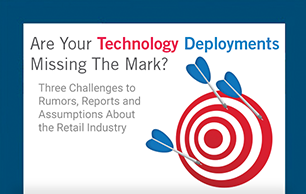 PWC’s annual 2018 Global Consumer Insights Survey, From mall to mobile: Adjusting to new consumer habits, offers a peek into changing consumer shopping trends and the expectations of new generations of shoppers. As you prioritize your retail technology investments and goals for 2019, it’s important to let consumers’ insights guide your efforts. According to the report, here are some emerging trends when it comes to shopper habits, patterns and expectations.
PWC’s annual 2018 Global Consumer Insights Survey, From mall to mobile: Adjusting to new consumer habits, offers a peek into changing consumer shopping trends and the expectations of new generations of shoppers. As you prioritize your retail technology investments and goals for 2019, it’s important to let consumers’ insights guide your efforts. According to the report, here are some emerging trends when it comes to shopper habits, patterns and expectations.
Mobile plus brick-and-mortar
Even with the growth of e-commerce, shoppers continue to visit brick-and-mortar stores as part of their shopping experience. In fact, they are combining use of mobile devices with in-store visits to complete their shopping experience. Whether leveraging BOPIS (buy online, pick up in store) or visiting the store to “touch and feel” merchandise and then ordering online for delivery, consumers are taking a mix-and-match approach to online and in-store shopping.
According to the survey, 50 percent of respondents use smartphones to complete payment at a brick-and-mortar store, either through customized orders in advance, in-store apps, or mobile payments at checkout. This statistic points to the importance of offering both in-store Wi-Fi as well as custom mobile apps that enhance and facilitate the customer experience. Without access to mobile shopping and payment options, consumers may lose interest and visit other retailers that can offer an omnichannel retail experience.
Speedy delivery is expected
As consumers shift from traditional fill-the-cart shopping in stores to omnichannel purchasing, speedy delivery is expected. While consumers may not enter stores to make a purchase and walk out with the physical goods, they do expect their merchandise to be delivered in an expedient manner. In the survey, 60 percent of respondents indicated that they expect goods to arrive same day, next day or within 2 days and 41 percent said they would be willing to pay extra for same day delivery.
This is an indication that retailers must become highly sophisticated logistics providers. In order to do this, precision inventory management is required, reverse logistics capabilities, and efficient back-end operations. The inability to deliver can seriously harm the brand and reduce revenues. Investments may be required in new technologies from RFID item-level identification to AI and robotics technologies that facilitate delivery planning.
Social media critical to the customer experience
Consumers want meaningful engagement with retailers. They want to see how other consumers rated products, insights into the heart of the retail operation, and custom offerings too meet their personalized needs. Social media is increasingly relevant to retailers on all fronts: from monitoring consumer concerns and preferences, to gathering preferences and using them to deliver relevant personalized offerings, to sharing meaningful brand insights with consumers. When asked where they went online to get inspiration for purchases, 37 percent of consumers chose social media. Many retailers are shifting their advertising budget from television and print to digital advertising. Retailers must invest in the customer experience through investments in social media, AI and in-store custom apps that combine to deliver the new age shopper the highly personalized, value-added shopping experience they expect.
As you continue to pursue the digital transformation in 2019 and beyond, it’s important to consider your capabilities and the shopping experience from your customers’ point of view. By offering a better customer experience, you can better compete in the market and generate interest from a new generation of shoppers. If you need help building the infrastructure, vetting technologies, or handling large-scale, multi-site deployments, contact us and find out how we can help you accomplish your goals in 2019.




